A Spatially-Explicit Economic and Financial Assessment of Closed-Loop Ground-Source Geothermal Heat Pumps: A Case Study for the Residential Buildings of Valle d’Aosta Region
Abstract
:1. Introduction
1.1. State of the Art and Related Studies
1.2. Scope of This Study
- Scenario 1 with both subsidies and rooftop photovoltaic systems;
- Scenario 2 without subsidies and with rooftop photovoltaic systems;
- Scenario 3 with subsidies and without rooftop photovoltaic systems;
- Scenario 4 without subsidies nor rooftop photovoltaic systems.
2. Study Area and Input Data
2.1. Study Area
2.2. Study Area Input Data and Relevant Assumptions
- Digital Surface Model (DSM) at 2 × 2 and 0.5 × 0.5 m of spatial resolution (source: GeoBrowser of the Region [45]);
- Digital Terrain Model (DTM) at 2 × 2 and 0.5 × 0.5 m of spatial resolution (source: GeoBrowser of the Region [45]);
- Estimated thermal demand of the residential buildings in kWh/m2/a and MWh/a [36];
- Average solar radiation (see Section 3.3) from DSM, DTM, and Albedo and Linke turbidity data derived from SODA [46];
- PV hourly profile derived from the Renewable Ninja project [47] (see Section 3.3);
- A survey was proposed in the Valle d’Aosta Region for the collection of average values for the financial and economic analysis including HPs, oil boilers, gas boilers, ACS costs and maintenance costs; electricity, oil and gas costs; gas and oil lower heating values. The results of the survey are reported in Appendix B.
3. Methods
- Section 3.1 describes the load curves that were implemented for the financial analysis necessary for the dimensioning of the tested technologies (GSHP, gas/oil boiler and ACS plants) for the four considered scenarios;
- Section 3.2 describes the calculation of the It (investment costs) term in Equations (1) (LCOE) and (2) (DPP) for the four scenarios;
- Section 3.4 describes how to calculate Rt − Ext (operation and maintenance costs and net expenditure, respectively) and Itcom (investment at year t that consider the difference between GSHP and other technologies) in Equation (2) for the four scenarios. Moreover, Section 3.4 briefly presents all the inputs for Equations (1) (LCOE) and (2) (DPP).
3.1. Thermal Loads and BHE
3.2. Calculation of the Investment Cost It and of Et
3.3. O&Mt and Ft Calculation for the Four Scenarios
3.4. Inputs of the Analysis
4. Results
5. Discussion
- The problems that might arise due to dense exploitation of the geothermal resource for heating and cooling (e.g., a set of inefficient plants due to reciprocal interference among adjacent systems) are not considered. All the calculations were carried out considering each building separately;
- The presence of hybrid systems (e.g., HP combined with an auxiliary gas boiler) is not considered;
- Many simplifications and assumptions were necessary to perform an analysis on more than 40,000 residential buildings. For instance, in the estimation of GSHP capital costs, installation and design costs were not directly estimated. Indeed, these specific costs were taken into account with a 40% increase in the excavation costs (see Appendix A). A previous study carried out on a Central European geographic context highlighted that the average BHE depth is about 100 m and that installation costs other than the heat pump and the borehole drilling are not negligible and are highly variable [56].
6. Conclusions
- The procedure and the methodology identified in this manuscript can be potentially replicated in other case studies. However, it is possible to conclude that a spatially explicit analysis (such as the one carried out in this manuscript) of the economic/financial feasibility of GSHP needs a robust set of input data;
- In particular, the followings inputs should be collected (or estimated from other sources of information):
- ○
- The geological properties of the study area;
- ○
- The hydraulic characteristics of the ground;
- ○
- The technical features of the considered buildings (i.e., thermal insulation, etc.);
- ○
- The load curve, which is the hourly thermal demand (heating and cooling) of the buildings;
- ○
- The thermal need required by the activities carried out within the buildings (different for residential, hotel, office, industrial processes, etc.);
- ○
- The investment, maintenance, and operative costs of the alternative technological solutions to perform effective economic/financial comparisons;
- ○
- All of the aforementioned information should be collected using redundant and robust methods, against uncertainties, to improve the reliability of the analysis;
- ○
- All of the aforementioned points should be spatially distributed and assessed to create the conditions for fast data integration (e.g., join of information).
- The method is affected by data abundance, data structure, and granularity. Input and easy-to-use data are needed to perform more reliable and frequent estimations at the building level.
- Due to the high variability of the GSHP potential, a spatial-based assessment of their economic and financial feasibility can support decision-makers in exploiting and incentivising this resource in a more effective way to increase its convenience. Subsidies can make a difference in the convenience of GSHP plants. In the author’s opinion, they are important in the transition phases, in which strong subsidies can enhance the spread of cleaner technologies.
Author Contributions
Funding
Acknowledgments
Conflicts of Interest
Appendix A
- The whole thermal demand was satisfied with HP plants (i.e., no auxiliary boilers were included in the analysis). Particularly, HP plants for heating, cooling, and domestic hot water were compared to a coupled natural gas boiler and air conditioning systems (ACS) and a coupled heating oil boiler and ACS. This assumption was made since hybrid systems (HP and boiler) are not available in the market for ground source heat pumps, therefore customized systems would be necessary.
- In these comparisons, the main working hypothesis was that HP plants are characterized by higher investment costs and lower annual costs [15], concerning the aforementioned boiler plus ACS.
- To evaluate the borehole heat exchanger (BHE) length, the ASHRAE method was used.
- Raster data on thermal conductivity, thermal capacity, thermal diffusivity, and ground temperature were provided by the GRETA project [54].
- The following parameters and assumptions were applied for the application of the ASHRAE [39] method for BHE:
- Peak hourly ground load, monthly ground load, yearly average ground load necessary for BHE dimensioning were estimated for each building considering the annual thermal demand and the normalized hourly profile according to [8];
- Fluid thermal heat capacity [J.kg−1K−1] = 3930 (propylene glycol 25%, see Ref. [59]);
- Fluid total mass flow rate per kW of peak hourly ground load [kg.s−1.kW−1] = 0.025 (this value was set assuming a temperature difference of 3 °C (see VDI 4640, Ref. [60]);
- Max/min heat pump inlet temperature [C] = -2.0 (the freezing point of PG25% is −10 °C, according to Ref. [61]);
- Borehole radius [m] = 0.075;
- Pipe inner radius [m] = 0.0137 (32 mm HDPE pipes);
- Pipe outer radius [m] = 0.0167 (32 mm HDPE pipes);
- Grout thermal conductivity [W.m−1.K−1] = 2.0 (typical conductivity value for geothermal grouts, see Ref. [61]);
- Pipe thermal conductivity [W.m−1.K−1] = 0.42 (HDPE pipes);
- Center-to-center distance between inlet and outlet pipes inside a BHE [m] = 0.0511;
- Internal convection coefficient [W.m−2.K−1] = 1000 [40];
- In the application of the ASHRAE method, a single borehole was considered, since the aim was only the estimation the cost of the excavation;
- The length of the BHE was increased by 3% to take into account the possible thermal interference among different BHEs, as this is was an intermediate value between 1 (no short-circuit) and 1.05 (strong short-circuit).
- One kW for seven square meters is the conversion factor implemented in Equation (14). Because we consider a 15% [62] average efficiency of a PV panel, and as we consider that a typical peak value is 1000 W/m2 on a terrestrial surface facing the sun on a clear day around solar noon at sea level, to obtain 1 kWp, the installed measures are necessary, 1/0.15 = 6.667 m2, so at least 7 m2. Given the availability of Digital Surface Model (DSM) data for the territory of Valle d’Aosta, including both terrain quotes and building roof ones, the GRASS GIS r.sun module [55] was used to estimate the beam solar irradiation over the whole year in clear-sky conditions. Roofs were considered as covered by a solar photovoltaic (PV) system (1 kW for 7 square meters) if the annual direct irradiation on the roof area was greater than the 75th percentile of the distribution of the beam solar irradiation. In particular, the main input data involved in the r.sun module computation were:
- An elevation raster map;
- An aspect raster map (map with the direction that slopes are facing counterclockwise from East: 90 degrees is North, 180 is West, 270 is South, 360 is East [63]);
- The Linke atmospheric turbidity raster map that was achieved interpolating Linke atmospheric turbidity data from the SoDa Service (http://www.soda-pro.com/—accessed, accessed on 11 November 2021), albedo data calculated by interpolating albedo data distributed by the SoDa Service, and horizon raster maps (step 5 sexagesimal degrees).
- Solar PV systems were implemented within the simulations and their contribution was evaluated by employing an LCOE of €0.09 for each produced kWh [64]. In this way, the solar PV investment cost was taken into account, even if it was not directly considered in the computations. In addition, sun hourly profiles used for the estimation of the produced energy by solar PV plants were gathered from the renewable ninja website (further details in [47]). Capital costs and annual costs of geothermal HP plants were obtained through regressions performed over surveyed data or from available references [37].
- Since the high variability and uncertainty of the analyzed cases in terms of building thermal demand, insulation, plant configuration, etc., (as depicted in [30]) it was not possible to calculate the plant installation cost of each component of the geothermal system. Therefore, to avoid unrealistic low GSHP capital cost estimations, the estimated excavation and HP costs (capital cost) were increased by 40%. This percentage is estimated from Ref. [30] to consider all the other system components that were not directly estimated in capital costs. Indeed, from Ref. [30] the costs of the heat pump and BHE account for about 60% of the cost breakdown of the GHSP system. For this reason, the estimated costs were increased by the value of 40% to obtain capital costs estimation more in line with the reference.
- The subsidies were estimated starting from the national regulation (i.e., Conto Termico in Italy) and directly subtracted from HP plant costs (i.e., they were not spread over the considered time span, since it may vary according to the plant power and the system efficiency).
- The hourly profiles of thermal demand were derived from the simulations performed by POLITO (further details in [37] and in “GRETA Project—Near-surface Geothermal Resources in the Territory of the Alpine Space—Alpine Space”, 2018) and from the estimation of the annual thermal demand for each residential building in the case study [37].
- BHE supposed unitary excavation cost equal to 150 €/m.
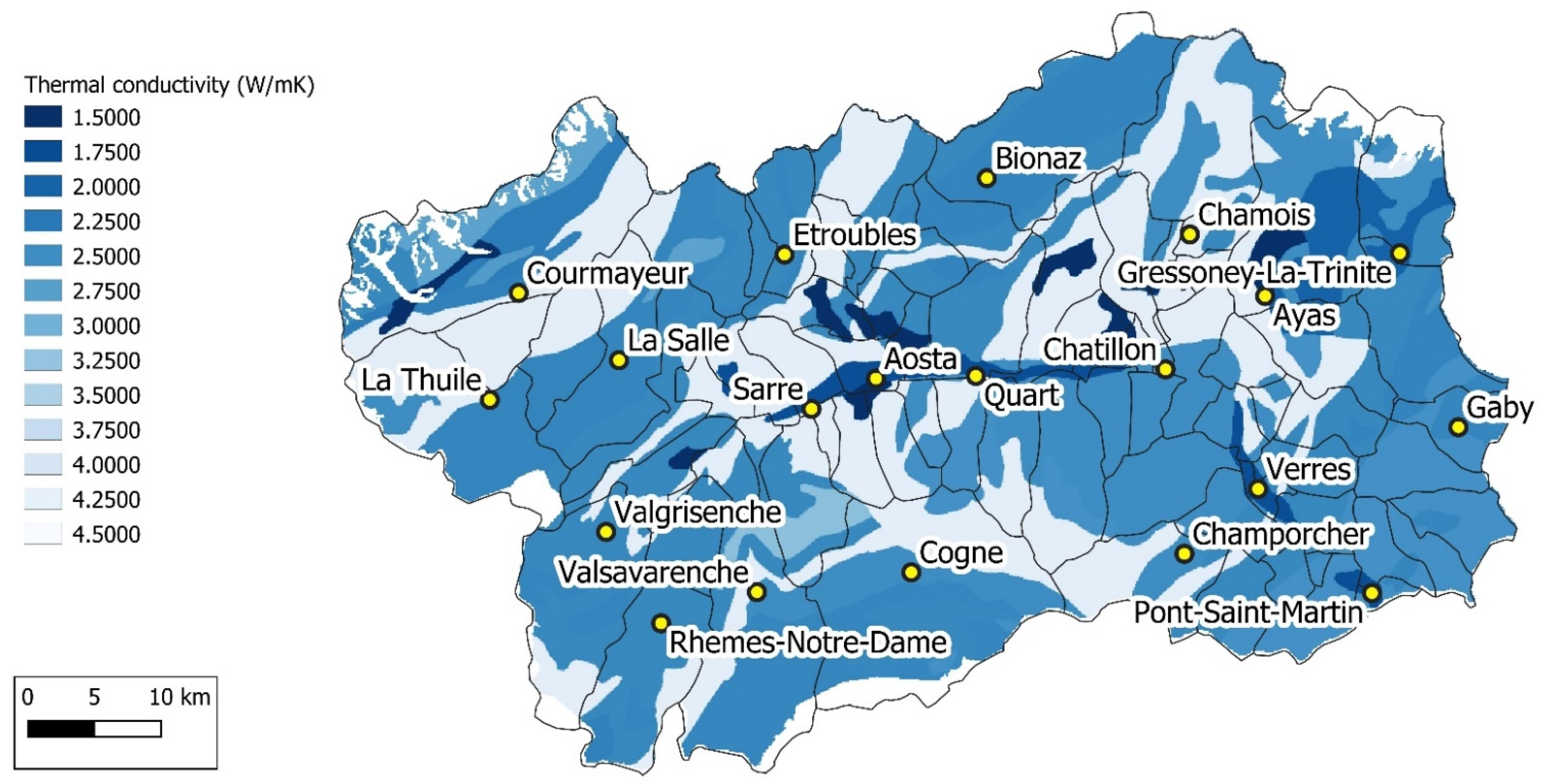
Appendix B
| Question | Thermal Power [kW] | Cost [EUR] | Annual Maintenance [EUR] |
|---|---|---|---|
| please provide five kW/cost/anno. Maintenance entries (possibly equally distributed) included in the range of 6–50 kW (heating performance). The cooling performance is supposed to be greater than 70% of the heating performance. | 7.6 | 10,176 | 91 |
| 13 | 12,305 | 177 | |
| 28.8 | 19,391 | 372 | |
| 42.8 | 25,965 | 488 | |
| 50 | 34,095 | 610 | |
| please provide five kW/cost entries (possibly equally distributed) included in the range of 51–250 kKW (heating performance). The cooling performance is supposed to be greater than 70% of the heating performance. | 57.6 | 42,112 | 792 |
| 85.6 | 51,924 | 1341 | |
| 134.6 | 45,332 | 1829 | |
| 173.2 | 53,544 | 2316 | |
| 222 | 59,699 | 2926 | |
| please provide five kW/cost entries (possibly equally distributed) included in the range of 251–600 kW (heating performance). The cooling performance is supposed to be greater than 70% of the heating performance. | 280 | 286,160 | 5320 |
| 340 | 347,480 | 6460 | |
| 400 | 408,800 | 7600 | |
| 490 | 500,780 | 9310 | |
| 560 | 572,320 | 10,640 |
| Question | Thermal Power [kW] | Cost [EUR] | Annual Maintenance [EUR] |
|---|---|---|---|
| please provide five kW/cost entries (possibly equally distributed) included in the range of 6–50 kW (heating performance). | 17.4 | 1780 | 91 |
| 23.8 | 1955 | 177 | |
| 32.1 | 2321 | 372 | |
| 40 | 7320 | 600 | |
| 50 | 9150 | 750 | |
| please provide five kW/cost entries (possibly equally distributed) included in the range of 51–250 kW (heating performance). | 65 | 11,895 | 975 |
| 110 | 20,130 | 1650 | |
| 150 | 27,450 | 2250 | |
| 190 | 34,770 | 2850 | |
| 240 | 43,920 | 3600 | |
| please provide five kW/cost entries (possibly equally distributed) included in the range of 251–600 kW (heating performance). | 280 | 51,240 | 4200 |
| 340 | 62,220 | 5100 | |
| 400 | 73,200 | 6000 | |
| 490 | 89,670 | 7350 | |
| 560 | 102,480 | 8400 |
| Question | Thermal Power [kW] | Cost [EUR] | Annual Maintenance [EUR] |
|---|---|---|---|
| please provide five kW/cost entries (possibly equally distributed) included in the range of 6–50 kW (heating performance). | 17.4 | 1780 | 91 |
| 23.8 | 1955 | 177 | |
| 32.1 | 2321 | 372 | |
| 40 | 7320 | 600 | |
| 50 | 9150 | 750 | |
| please provide five kW/cost entries (possibly equally distributed) included in the range of 51–250 kW (heating performance). | 65 | 11,895 | 975 |
| 110 | 20,130 | 1650 | |
| 150 | 27,450 | 2250 | |
| 190 | 34,770 | 2850 | |
| 240 | 43,920 | 3600 | |
| please provide five kW/cost entries (possibly equally distributed) included in the range of 251–600 kW (heating performance). | 280 | 51,240 | 4200 |
| 340 | 62,220 | 5100 | |
| 400 | 73,200 | 6000 | |
| 490 | 89,670 | 7350 | |
| 560 | 102,480 | 8400 |
| Question | Thermal Power [kW] | Cost [EUR] | Annual Maintenance [EUR] |
|---|---|---|---|
| please provide five kW/cost entries (possibly equally distributed) included in the range of 6–50 kW (heating performance). | 17.4 | 1780 | 91 |
| 23.8 | 1955 | 177 | |
| 32.1 | 2321 | 372 | |
| 40 | 7320 | 600 | |
| 50 | 9150 | 750 | |
| please provide five kW/cost entries (possibly equally distributed) included in the range of 51–250 kW (heating performance). | 65 | 11,895 | 975 |
| 110 | 20,130 | 1650 | |
| 150 | 27,450 | 2250 | |
| 190 | 34,770 | 2850 | |
| 240 | 43,920 | 3600 | |
| please provide five kW/cost entries (possibly equally distributed) included in the range of 251–600 kW (heating performance). | 280 | 51,240 | 4200 |
| 340 | 62,220 | 5100 | |
| 400 | 73,200 | 6000 | |
| 490 | 89,670 | 7350 | |
| 560 | 102,480 | 8400 |
| Technical Feature | Value |
|---|---|
| Electricity price [EUR/kWh] | 0.21 |
| Gas price [EUR/Sm3] | 0.8 |
| Heating oil price [EUR/l] | 1.4 |
| Gas lower heating value [MJ/Sm3] | 34 |
| Oil lower heating value [MJ/kg] | 40 |
References
- Laustsen, J. Energy Efficiency Requirements in Building Codes, Energy Efficiency Policies for New Buildings. IEA Information Paper. Support of the G8 Plan of Action. 2008. Available online: https://www.iea.org/reports/energy-efficiency-requirements-in-building-codes-policies-for-new-buildings (accessed on 1 November 2021).
- Pezzutto, S.; Croce, S.; Zambotti, S.; Kranzl, L.; Novelli, A.; Zambelli, P. Assessment of the Space Heating and Domestic Hot Water Market in Europe—Open Data and Results. Energies 2019, 12, 1760. [Google Scholar] [CrossRef] [Green Version]
- Pezzutto, S.; Fazeli, R.; De Felice, M.; Sparber, W. Future Development of the Air-Conditioning Market in Europe: An Outlook until 2020. Wiley Interdiscip. Rev. Energy Environ. 2016, 5, 649–669. [Google Scholar] [CrossRef]
- Polesello, V.; Johnson, K. Energy-Efficient Buildings for Low-Carbon Cities. ICCG Reflect. 2016, 47, 1–9. [Google Scholar]
- EHPA. European Heat Pump Market and Statistic Report 2017 & Stats Tool. Available online: https://www.ehpa.org/market-data/2017/ (accessed on 11 November 2021).
- Heinonen, J.; Laine, J.; Pluuman, K.; Säynäjoki, E.-S.; Soukka, R.; Junnila, S. Planning for a Low Carbon Future? Comparing Heat Pumps and Cogeneration as the Energy System Options for a New Residential Area. Energies 2015, 8, 9137–9154. [Google Scholar] [CrossRef] [Green Version]
- Bayer, P.; Saner, D.; Bolay, S.; Rybach, L.; Blum, P. Greenhouse Gas Emission Savings of Ground Source Heat Pump Systems in Europe: A Review. Renew. Sustain. Energy Rev. 2012, 16, 1256–1267. [Google Scholar] [CrossRef]
- Rivoire, M.; Casasso, A.; Piga, B.; Sethi, R.; Rivoire, M.; Casasso, A.; Piga, B.; Sethi, R. Assessment of Energetic, Economic and Environmental Performance of Ground-Coupled Heat Pumps. Energies 2018, 11, 1941. [Google Scholar] [CrossRef] [Green Version]
- Lund, J.W.; Boyd, T.L. Direct Utilization of Geothermal Energy 2015 Worldwide Review. Geothermics 2016, 60, 66–93. [Google Scholar] [CrossRef]
- Staffell, I.; Brett, D.; Brandon, N.; Hawkes, A. A Review of Domestic Heat Pumps. Energy Environ. Sci. 2012, 5, 9291–9306. [Google Scholar] [CrossRef]
- Lund, J.W. Direct Utilization of Geothermal Energy. Energies 2010, 3, 1443–1471. [Google Scholar] [CrossRef]
- Florides, G.; Kalogirou, S. Ground Heat Exchangers—A Review of Systems, Models and Applications. Renew. Energy 2007, 32, 2461–2478. [Google Scholar] [CrossRef]
- Kavanaugh, S.; Gilbreath, C.; Kilpatrick, J. Cost Containment for Ground-Source Heat Pumps, Final Report. Available online: https://bit.ly/2XaC0xH (accessed on 19 May 2020).
- Petit, P.J.; Meyer, J.P. Economic Potential of Vertical Ground-Source Heat Pumps Compared to Air-Source Air Conditioners in South Africa. Energy 1998, 23, 137–143. [Google Scholar] [CrossRef]
- Shonder, J.A.; Martin, M.A.; Hughes, P.J.; Thornton, J. Geothermal Heat Pumps in K-12 Schools: A Case Study of the Lincoln, Nebraska Schools. Available online: https://digitalcommons.unl.edu/usdoepub/30/ (accessed on 19 May 2020).
- Self, S.J.; Reddy, B.V.; Rosen, M.A. Geothermal Heat Pump Systems: Status Review and Comparison with Other Heating Options. Appl. Energy 2013, 101, 341–348. [Google Scholar] [CrossRef]
- Chiasson, A.D.; Yavuzturk, C.; Talbert, W.J. Design of School Building HVAC Retrofit with Hybrid Geothermal Heat-Pump System. J. Archit. Eng. 2004, 10, 103–111. [Google Scholar] [CrossRef]
- Chiasson, A.D. Greenhouse Heating with Geothermal Heat Pump Systems. Available online: https://bit.ly/3bPanQ2 (accessed on 11 November 2021).
- Chiasson, A. Final Report Life-Cycle Cost Study of a Geothermal Heat Pump System BIA Office BLDG. Available online: https://bit.ly/2LEA4IF (accessed on 19 May 2020).
- Esen, H.; Inalli, M.; Esen, M. Technoeconomic Appraisal of a Ground Source Heat Pump System for a Heating Season in Eastern Turkey. Energy Convers. Manag. 2006, 47, 1281–1297. [Google Scholar] [CrossRef]
- Esen, H.; Inalli, M.; Esen, M. A Techno-Economic Comparison of Ground-Coupled and Air-Coupled Heat Pump System for Space Cooling. Build. Environ. 2007, 42, 1955–1965. [Google Scholar] [CrossRef]
- Badescu, V. Economic Aspects of Using Ground Thermal Energy for Passive House Heating. Renew. Energy 2007, 32, 895–903. [Google Scholar] [CrossRef]
- Hanova, J.; Dowlatabadi, H. Strategic GHG Reduction through the Use of Ground Source Heat Pump Technology. Environ. Res. Lett. 2007, 2, 044001. [Google Scholar] [CrossRef]
- Dickinson, J.; Jackson, T.; Matthews, M.; Cripps, A. The Economic and Environmental Optimisation of Integrating Ground Source Energy Systems into Buildings. Energy 2009, 34, 2215–2222. [Google Scholar] [CrossRef]
- Zhu, Y.; Tao, Y.; Rayegan, R. A Comparison of Deterministic and Probabilistic Life Cycle Cost Analyses of Ground Source Heat Pump (GSHP) Applications in Hot and Humid Climate. Energy Build. 2012, 55, 312–321. [Google Scholar] [CrossRef]
- De Carli, M.; Galgaro, A.; Pasqualetto, M.; Zarrella, A. Energetic and Economic Aspects of a Heating and Cooling District in a Mild Climate Based on Closed Loop Ground Source Heat Pump. Appl. Therm. Eng. 2014, 71, 895–904. [Google Scholar] [CrossRef]
- Sivasakthivel, T.; Murugesan, K.; Sahoo, P.K. Study of Technical, Economical and Environmental Viability of Ground Source Heat Pump System for Himalayan Cities of India. Renew. Sustain. Energy Rev. 2015, 48, 452–462. [Google Scholar] [CrossRef]
- Hakkaki-Fard, A.; Eslami-Nejad, P.; Aidoun, Z.; Ouzzane, M. A Techno-Economic Comparison of a Direct Expansion Ground-Source and an Air-Source Heat Pump System in Canadian Cold Climates. Energy 2015, 87, 49–59. [Google Scholar] [CrossRef]
- Gabrielli, L.; Bottarelli, M. Financial and Economic Analysis for Ground-Coupled Heat Pumps Using Shallow Ground Heat Exchangers. Sustain. Cities Soc. 2016, 20, 71–80. [Google Scholar] [CrossRef]
- Lu, Q.; Narsilio, G.A.; Aditya, G.R.; Johnston, I.W. Economic Analysis of Vertical Ground Source Heat Pump Systems in Melbourne. Energy 2017, 125, 107–117. [Google Scholar] [CrossRef]
- Cui, Y.; Zhu, J.; Twaha, S.; Chu, J.; Bai, H.; Huang, K.; Chen, X.; Zoras, S.; Soleimani, Z. Techno-Economic Assessment of the Horizontal Geothermal Heat Pump Systems: A Comprehensive Review. Energy Convers. Manag. 2019, 191, 208–236. [Google Scholar] [CrossRef]
- Biglarian, H.; Saidi, M.H.; Abbaspour, M. Economic and Environmental Assessment of a Solar-Assisted Ground Source Heat Pump System in a Heating-Dominated Climate. Int. J. Environ. Sci. Technol. 2019, 16, 3091–3098. [Google Scholar] [CrossRef]
- Miglani, S.; Orehounig, K.; Carmeliet, J. A Methodology to Calculate Long-Term Shallow Geothermal Energy Potential for an Urban Neighbourhood. Energy Build. 2018, 159, 462–473. [Google Scholar] [CrossRef] [Green Version]
- Kikuchi, E.; Bristow, D.; Kennedy, C.A. Evaluation of Region-Specific Residential Energy Systems for GHG Reductions: Case Studies in Canadian Cities. Energy Policy 2009, 37, 1257–1266. [Google Scholar] [CrossRef]
- Saner, D.; Juraske, R.; Kübert, M.; Blum, P.; Hellweg, S.; Bayer, P. Is It Only CO2 That Matters? A Life Cycle Perspective on Shallow Geothermal Systems. Renew. Sustain. Energy Rev. 2010, 14, 1798–1813. [Google Scholar] [CrossRef]
- D’Alonzo, V.; Novelli, A.; Vaccaro, R.; Vettorato, D.; Albatici, R.; Diamantini, C.; Zambelli, P. A Bottom-up Spatially Explicit Methodology to Estimate the Space Heating Demand of the Building Stock at Regional Scale. Energy Build. 2020, 206, 109581. [Google Scholar] [CrossRef]
- GRETA Project. D5.1.1 A Spatial Explicit Assessment of the Economic and Financial Feasibility of Near Surface Geothermal Energy; Eurac Research: Bolzano, Italy, 2018. [Google Scholar]
- GRETA Project. D5.2.1 Report on the Test of the Integration of NSGE into Energy Plans for the Selected Pilot Areas; Eurac Research: Bolzano, Italy, 2018. [Google Scholar]
- ASHRAE. Geothermal Heating and Cooling: Design of Ground-Source Heat Pump Systems. Available online: https://www.ashrae.org/technical-resources/bookstore/geothermal-heating-and-cooling-design-of-ground-source-heat-pump-systems (accessed on 27 June 2018).
- Philippe, M.; Bernier, M.; Marchio, D. Sizing Calculation Spreadsheet: Vertical Geothermal Borefields (Zip File). ASHRAE J. 2010, 52, 20–28. [Google Scholar]
- GSE Conto Termico. Available online: https://www.gse.it/servizi-per-te/efficienza-energetica/conto-termico (accessed on 3 March 2020).
- Casasso, A.; Della Valentina, S.; Di Feo, A.F.; Capodaglio, P.; Cavorsin, R.; Guglielminotti, R.; Sethi, R. Ground Source Heat Pumps in Aosta Valley (NW Italy): Assessment of Existing Systems and Planning Tools for Future Installations. ROL 2018, 46, 59–66. [Google Scholar] [CrossRef] [Green Version]
- Regione Autonoma Valle d’Aosta Piano Energetico Ambientale Regionale (PEAR). 2012.
- Regione Autonoma Valle d’Aosta Monitoraggio del PEAR. 2018.
- GeoPortale—Portale dei dati Territoriali della Valle d’Aosta. Available online: http://geoportale.regione.vda.it/ (accessed on 27 June 2018).
- Home—Www.Soda-pro.Com. Available online: http://www.soda-pro.com/home (accessed on 28 September 2018).
- Pfenninger, S.; Staffell, I. Energy. 1 November 2016, pp. 1251–1265. Available online: https://econpapers.repec.org/article/eeeenergy/v_3a114_3ay_3a2016_3ai_3ac_3ap_3a1251-1265.htm (accessed on 11 November 2021).
- Decreto Interministeriale 16 Febbraio 2016—Aggiornamento Conto Termico. Available online: https://www.mise.gov.it/index.php/it/normativa/decreti-interministeriali/2034123-decreto-interministeriale-16-febbraio-2016-aggiornamento-conto-termico (accessed on 5 April 2020).
- U.S. Energy Information Administration. Levelized Cost and Levelized Avoided Cost of New Generation Resources in the Annual Energy Outlook 2020; U.S. Energy Information Administration: Washington, DC, USA, 2018.
- Welcome to Python.Org. Available online: https://www.python.org/ (accessed on 28 October 2021).
- Klein, S.A.; Beckman, W.A.; Mitchell, J.W.; Duffie, J.A.; Duffie, N.A.; Freeman, T.L.; Mitchell, J.C.; Braun, J.E.; Evans, B.L.; Kummer, J.P. TRNSYS 16–A TRaNsient System Simulation Program, User Manual; Solar Energy Laboratory, University of Wisconsin-Madison: Madison, WI, USA, 2004. [Google Scholar]
- Klein, S.A.; Beckman, W.A.; Mitchell, J.W.; Duffie, J.A.; Duffie, N.A.; Freeman, T.L.; Mitchell, J.C.; Braun, J.E.; Evans, B.L.; Kummer, J.P. Trnsys 16—Volume 3 Standard Component Library Overview; Solar Energy Laboratory, University of Wisconsin: Madison, WI, USA, 2005; p. 92. [Google Scholar]
- Tsikaloudaki, K.; Laskos, K.; Bikas, D. On the Establishment of Climatic Zones in Europe with Regard to the Energy Performance of Buildings. Energies 2012, 5, 32–44. [Google Scholar] [CrossRef]
- GRETA Project. D4.2.1 Local-Scale Maps of the NSGE Potential in the Case Study Areas, 2018.
- Hofierka, J.; Suri, M. The Solar Radiation Model for Open Source GIS: Implementation and Applications. 2002. Available online: https://www.researchgate.net/publication/2539232_The_solar_radiation_model_for_Open_source_GIS_Implementation_and_applications (accessed on 11 November 2021).
- Sanner, B.; Karytsas, C.; Mendrinos, D.; Rybach, L. Current Status of Ground Source Heat Pumps and Underground Thermal Energy Storage in Europe. Geothermics 2003, 32, 579–588. [Google Scholar] [CrossRef]
- Edenhofer, O.; Madruga, R.P.; Sokona, Y.; Seyboth, K.; Eickemeier, P.; Matschoss, P.; Hansen, G.; Kadner, S.; Schlömer, S.; Zwickel, T.; et al. Renewable Energy Sources and Climate Change Mitigation Special Report of the Intergovernmental Panel on Climate Change; Cambridge University Press: Cambridge, UK, 2012; ISBN 978-1-107-60710-1. [Google Scholar]
- Watkins, D.E. Heating Services in Buildings; John Wiley & Sons: Hoboken, NJ, USA, 2011; ISBN 978-1-119-97166-5. [Google Scholar]
- Bartolini, N.; Casasso, A.; Bianco, C.; Sethi, R. Environmental and Economic Impact of the Antifreeze Agents in Geothermal Heat Exchangers. Energies 2020, 13, 5653. [Google Scholar] [CrossRef]
- VDI 4640 Blatt 1—Thermal Use of the Underground—Fundamentals, Approvals, Environmental Aspects. 2010. Available online: https://www.vdi.de/en/home/vdi-standards/details/vdi-4640-blatt-1-thermal-use-of-the-underground-fundamentals-approvals-environmental-aspects (accessed on 11 November 2021).
- Mahmoud, M.; Ramadan, M.; Pullen, K.; Abdelkareem, M.A.; Wilberforce, T.; Olabi, A.-G.; Naher, S. A Review of Grout Materials in Geothermal Energy Applications. Int. J. Thermofluids 2021, 10, 100070. [Google Scholar] [CrossRef]
- Ouédraogo, A.; Zouma, B.; Ouédraogo, E.; Guissou, L.; Bathiébo, D.J. Individual Efficiencies of a Polycrystalline Silicon PV Cell versus Temperature. Results Opt. 2021, 4, 100101. [Google Scholar] [CrossRef]
- R.Slope.Aspect—GRASS GIS Manual. Available online: https://grass.osgeo.org/grass78/manuals/r.slope.aspect.html (accessed on 28 October 2021).
- Vartiainen, E.; Masson, G.; Breyer, C. PV LCOE in Europe 2014-30. 2015. Available online: https://etip-pv.eu/publications/etip-pv-publications/download/pv-costs-in-europe-2014-2030 (accessed on 4 April 2020).
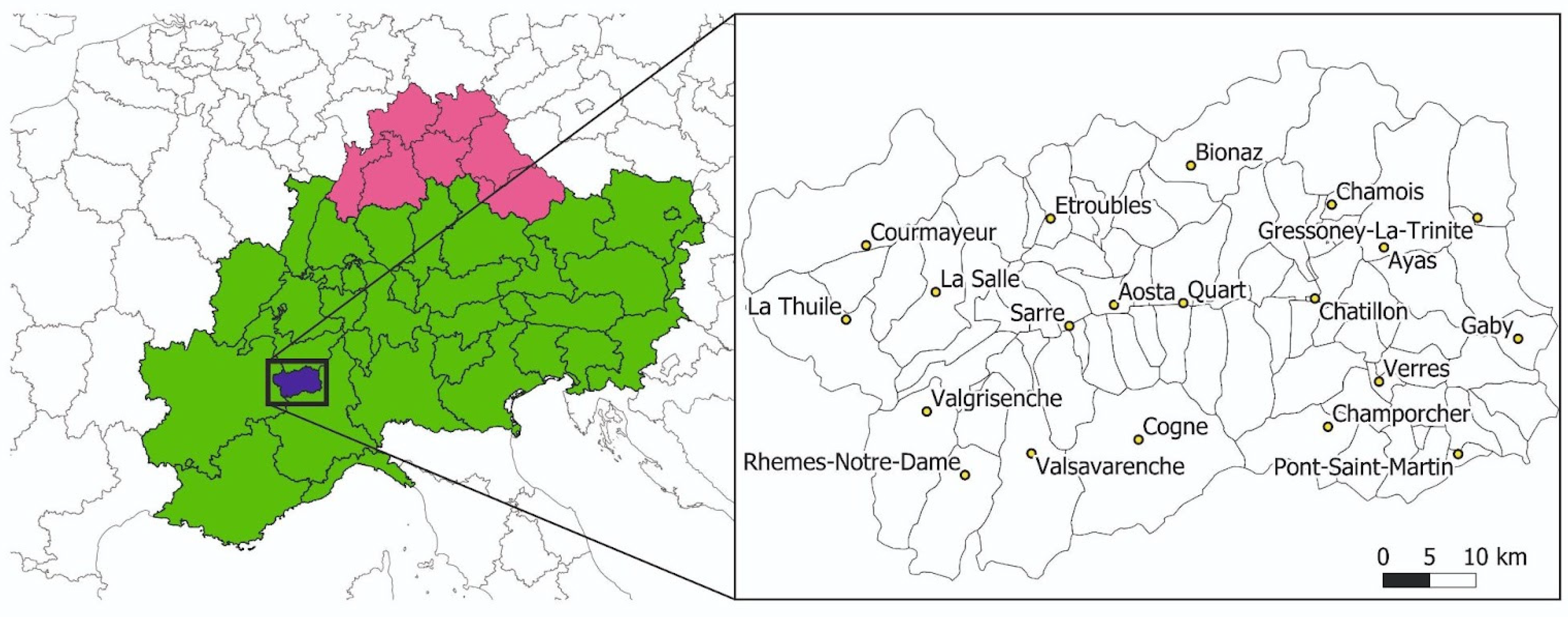
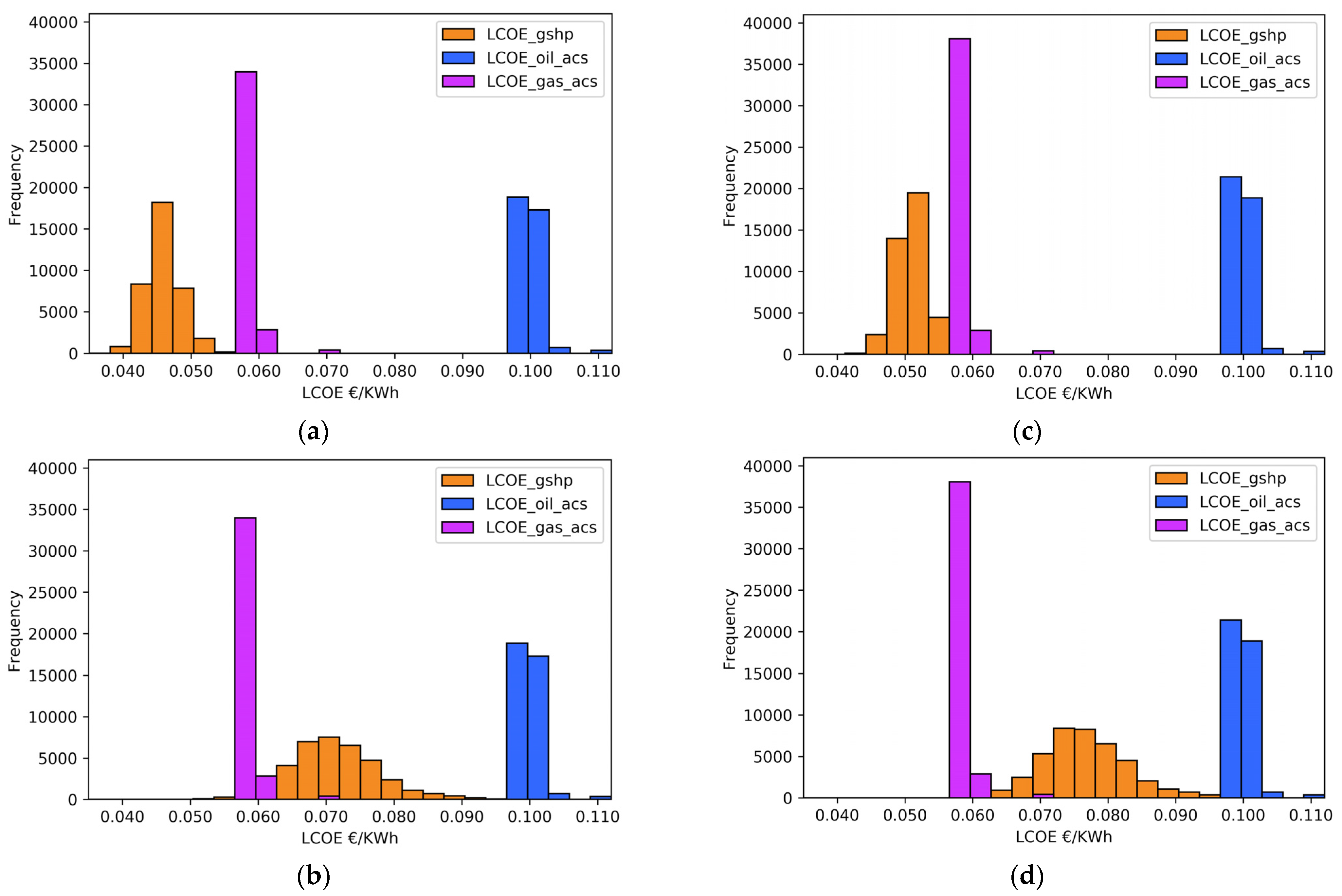
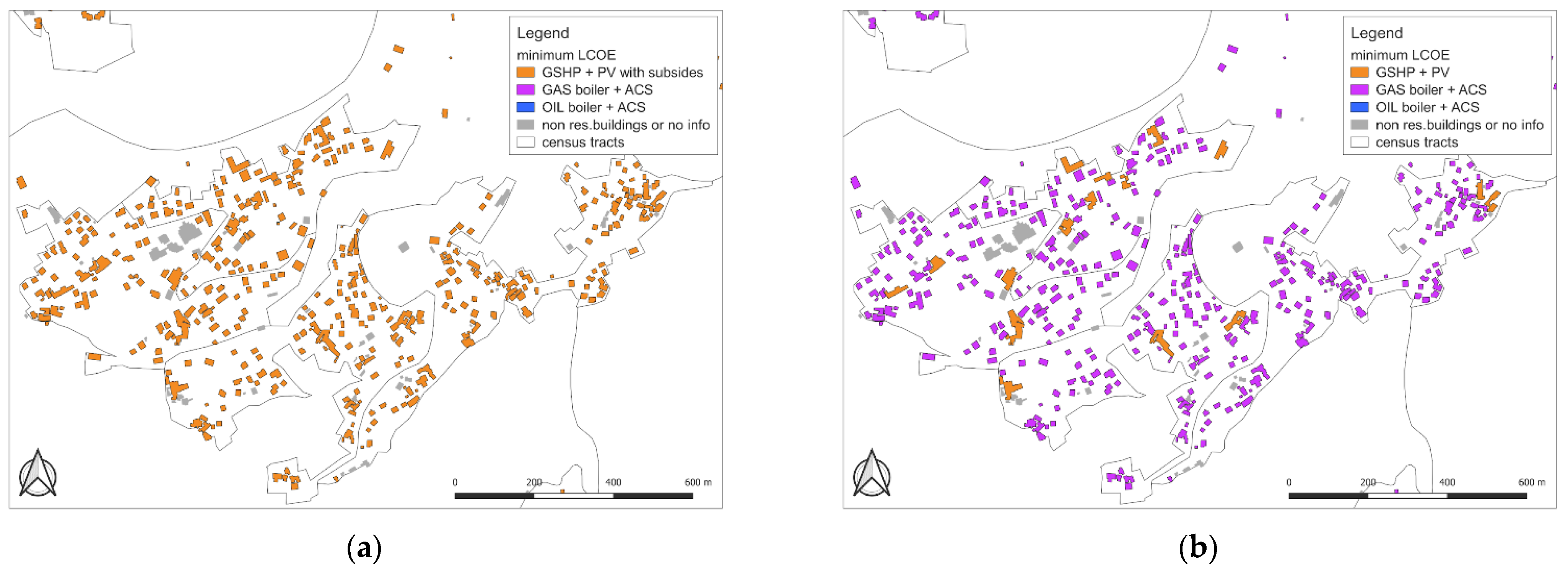
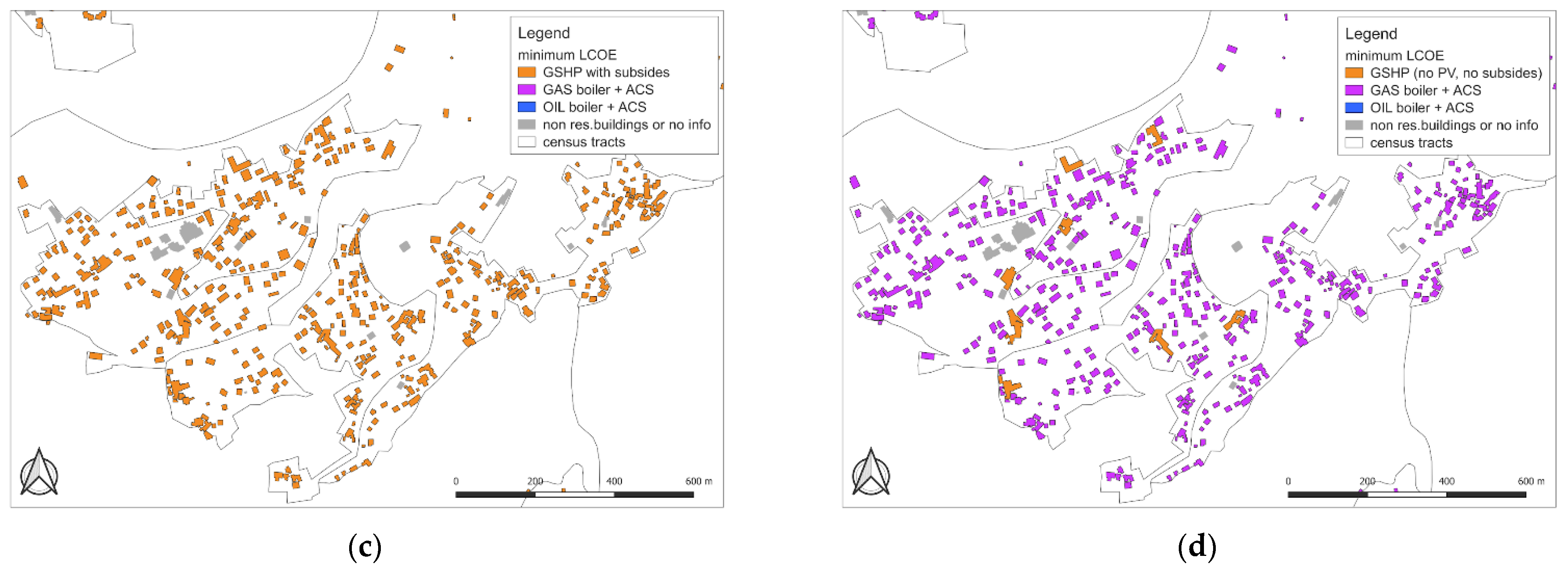
| It | O&Mt | Ft | |
|---|---|---|---|
| Gas Boiler and ACS | |||
| Oil Boiler and ACS | |||
| GHSP Scenario 1 | |||
| GHSP Scenario 2 | |||
| GHSP Scenario 3 | |||
| GHSP Scenario 4 |
| Itcomm | Rt − Et | |
|---|---|---|
| GHSP Scenario 1 and gas boiler/ACS | ||
| GHSP Scenario 2 and gas boiler/ACS | ||
| GHSP Scenario 3 and gas boiler/ACS | ||
| GHSP Scenario 4 and gas boiler/ACS |
| Itcomm | Rt − Et | |
|---|---|---|
| GHSP Scenario 1 and oil boiler/ACS | ||
| GHSP Scenario 2 and oil boiler/ACS | ||
| GHSP Scenario 3 and oil boiler/ACS | ||
| GHSP Scenario 4 and oil boiler/ACS |
| LCOE_gshp | ||||||
|---|---|---|---|---|---|---|
| Scenario 1 | Scenario 2 | Scenario 3 | Scenario 4 | LCOE_Oil_Acs | LCOE_Gas_Acs | |
| Average | 0.046 | 0.071 | 0.051 | 0.077 | 0.100 | 0.059 |
| Std Deviation | 0.003 | 0.008 | 0.003 | 0.008 | 0.001 | 0.001 |
| Median | 0.046 | 0.071 | 0.051 | 0.076 | 0.100 | 0.058 |
| Skewness | 35.893 | 32.268 | 36.026 | 29.663 | 3.736 | 6.251 |
| Kurtosis | 3231.625 | 2800.181 | 3379.630 | 2592.325 | 59.727 | 61.125 |
| Mean DPP GSHP vs. Oil_Acs | Mean DPP GSHP vs. Gas_Acs | |
|---|---|---|
| Scenario 1 | 4.2 | 13.2 |
| Scenario 2 | 13.8 | 24.3 |
| Scenario 3 | 4.6 | 17.6 |
| Scenario 4 | 15.3 | 26.7 |
Publisher’s Note: MDPI stays neutral with regard to jurisdictional claims in published maps and institutional affiliations. |
© 2021 by the authors. Licensee MDPI, Basel, Switzerland. This article is an open access article distributed under the terms and conditions of the Creative Commons Attribution (CC BY) license (https://creativecommons.org/licenses/by/4.0/).
Share and Cite
Novelli, A.; D’Alonzo, V.; Pezzutto, S.; Poggio, R.A.E.; Casasso, A.; Zambelli, P. A Spatially-Explicit Economic and Financial Assessment of Closed-Loop Ground-Source Geothermal Heat Pumps: A Case Study for the Residential Buildings of Valle d’Aosta Region. Sustainability 2021, 13, 12516. https://doi.org/10.3390/su132212516
Novelli A, D’Alonzo V, Pezzutto S, Poggio RAE, Casasso A, Zambelli P. A Spatially-Explicit Economic and Financial Assessment of Closed-Loop Ground-Source Geothermal Heat Pumps: A Case Study for the Residential Buildings of Valle d’Aosta Region. Sustainability. 2021; 13(22):12516. https://doi.org/10.3390/su132212516
Chicago/Turabian StyleNovelli, Antonio, Valentina D’Alonzo, Simon Pezzutto, Rubén Aarón Estrada Poggio, Alessandro Casasso, and Pietro Zambelli. 2021. "A Spatially-Explicit Economic and Financial Assessment of Closed-Loop Ground-Source Geothermal Heat Pumps: A Case Study for the Residential Buildings of Valle d’Aosta Region" Sustainability 13, no. 22: 12516. https://doi.org/10.3390/su132212516
APA StyleNovelli, A., D’Alonzo, V., Pezzutto, S., Poggio, R. A. E., Casasso, A., & Zambelli, P. (2021). A Spatially-Explicit Economic and Financial Assessment of Closed-Loop Ground-Source Geothermal Heat Pumps: A Case Study for the Residential Buildings of Valle d’Aosta Region. Sustainability, 13(22), 12516. https://doi.org/10.3390/su132212516









